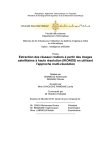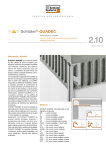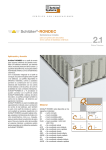Download Philips DesignLine Tilt LED TV 26PDL4906H 26" HD-Ready Black
Transcript
Register your product and get support at www.philips.com/welcome 47PFL4606H 46PFL5606H 42PFL4x06H 42PFL3x06H 40PFL5xx6H 37PFL4606H 32PFL5x06H 32PFL4606H 32PFL3x06H 26PDL49x6H 22PDL49x6H DesignLine Tilt EN User manual EN BG Addendum When you select a channel from the channel grid, a preview is not displayed. Допълнение Когато изберете канал от мрежата с канали, на дисплея не се показва преглед. CS Dodatek Při výběru kanálu z mřížky není náhled zobrazen. DA Tillæg Når du vælger en kanal fra kanaloversigten, er der ikke nogen eksempelvisning. DE Nachtrag Wenn Sie einen Sender aus der Senderliste auswählen, wird keine Vorschau angezeigt. EL Παράρτημα Όταν επιλέγετε ένα κανάλι από το δίκτυο καναλιών, δεν εμφανίζεται προεπισκόπηση. ES Apéndice Cuando se selecciona un canal de la parrilla, no se muestra una vista previa. ET Lisa Kui valite kanali kanalite tabelist, siis eelvaadet ei kuvata. HR Dodatak Kada odaberete kanal s mreže kanala, pretpregled se ne prikazuje. HU Függelék A mikor kijelöl egy csatornát a csatornák táblázatában, nem jelenik meg előnézeti kép. IT Integrazione Quando si seleziona un canale dalla relativa griglia, l’anteprima non viene visualizzata. KK Қосымша Арналар кестесінен арна таңдалғанда алдын ала қарау мүмкіндігі болмайды. LV Pielikums Kad izvēlaties kanālu no kanālu tīkla, priekšskatījums netiek radīts. LT Priedas Renkantis kanalą iš kanalų tinklelio, peržiūra nerodoma. NL Addendum Wanneer u een zender selecteert in de zenderlijst, krijgt u geen voorbeeld te zien. NOAddendum Når du velger en kanal fra kanalnettet, vil forhåndsvisning ikke bli vist. PL Dodatek Podgląd nie wyświetla się po wybraniu kanału z siatki kanałów. FI Lisäys Kun valitset kanavan kanavaruudukosta, esikatselua ei näytetä. PT Adenda Quando selecciona um canal na grelha de canais, não é apresentada uma pré-visualização. FR RO Anexă Când selectaţi un canal din grila de canale, nu este afişată o imagine de examinare. Addenda Lorsque vous sélectionnez une chaîne dans la grille des chaînes, aucun aperçu n’est disponible. RU Приложение При выборе канала из таблицы каналов предварительный просмотр не отображается. SV Tillägg När du markerar en kanal i kanalöversikten visas ingen förhandsgranskning. SK Príloha Keď vyberiete kanál z mriežky kanálov, ukážka sa nezobrazí. TR Ek Kanal ızgarasından bir kanal seçtiğinizde, bir önizleme görüntülenmez. UK Додаток Під час вибору каналів з таблиці каналів попередній перегляд не відображається. SL Dodatek Ko na seznamu kanalov izberete kanal, ni prikazan predogled. SR Dodatak Kada izaberete kanal iz mreže kanala, pregled se ne prikazuje. الملحقAR ال يتم،عندما تختار قناة من قائمت شبكت القنواث .عرض المعاينت PS TS .mpg .mpeg .vob .ts MP4 MKV AVI FLV MP3 MKV AAC (.mov and .3gpp extensions are not supported) .mkv .mp4 .avi .flv .mp3 .wav .aac .mp4 .m4a .mp4 Container File Extensions NA NA NA 1920x1080 H.264 BP/MP/HP LV 4.0 NA YES 40 Mbps 30 352x288 Sorenson NA YES 30 Mbps 30 1280x720 Motion JPEG NA YES 40 Mbps 30 1920x1080 MPEG4 SP@L 3.0/ ASP@HL 4.0 NA NA NA 30 30 ACC-LC/HE-AAC PCM/ADPCM/A-law PCM/ u-law PCM 16bit PCM(big/little endian) 24bit PCM(big endian) 16-576 kbits/s MP3 MPEG1 Layer1/2, MP3, MPEG2 AAC-LC, MPEG4 AAC-LC/HE-AAC 32/40/48/56/64/80/96/ 112/128/160/192/224/ 256/320 kbits/s 40 Mbps 40 Mbps wav:PCM/ADPCM/A-law PCM/u-law PCM, MPEG1 Layer 1/2, MP3, MPEG2 AAC-LC, MPEG4 AAC-LC/HE-AAC, AC3 1920x1080 40 Mbps YES YES YES YES YES YES YES YES H.264 BP/MP/HP LV 4.0 30 1.8 Mbps 40 Mbps 1920x1080 30 30 MPEG2 MP@HL YES YES 768x576 wav:PCM/ADPCM/A-law PCM/u-law PCM, MPEG1 Layer1/2, MP3, MPEG2 AAC-LC, MPEG4 AAC-LC/HE-AAC, AC3 MPEG1 40 Mbps 40 Mbps YES YES YES YES YES YES YES YES 1920x1080 30 30 30 Mbps MPEG1 Layer1/2, MP3, MPEG2 AAC-LC, MPEG4 AAC-LC/HE-AAC MPEG1 Layer1/2, AC3 MPEG2 AAC-LC, MPEG4 AAC-LC/ HE-AAC, AC3 MP1 Layer1/2, MP3, AC3, DVD LPCM 1920x1080 1920x1080 H.264 BP/MP/HP LV 4.0 30 40 Mbps 40 Mbps 40 Mbps 40 Mbps 40 Mbps 40 Mbps 1.8 Mbps USB XviD 1280x720 Motion JPEG (*.mov only) 30 30 30 30 30 30 30 Audio codec MPEG4 SP@L 3.0/ ASP@HL 4.0 1408x1152 1920x1080 H.264 BP/MP/HP LV 4.0 1920x1080 1920x1080 H.264 BP/MP/HP LV 4.0 H.263 1920x1080 MPEG2 MP@HL MPEG4 SP@L 3.0/ ASP@HL 4.0 768x576 1920x1080 MPEG1 Maximum resolution Max. Frame Rate (fps) Max. Bit Rate (Mbps) MPEG2 MP@HL Video codec Supported audio/video formats Contact information België/ Belgique 0800 80 190 Gratis/Gratuit ß chat www.philips.com/support България 00800 11 544 24 Česká republika 800 142 840 Bezplatný hovor Danmark 3525 8759 Lokalt opkald ß chat www.philips.com/support Deutschland 0800 000 7520 (kostenfrei) ß chat www.philips.com/support Ελλάδα 0 0800 3122 1280 Κλήση χωρίς χρέωση España 900 800 655 Teléfono local gratuito solamente para clientes en España ß chat www.philips.com/support Estonia 8000100288 kohalik kõne tariifi France 0805 025 510 numéro sans frais ß chat www.philips.com/support Hrvatska 0800 222778 free Ireland South: 1 800 7445477 North: 0 800 331 6015 Italia 800 088774 Numero Verde Қазақстан +7 727 250 66 17 local Latvia 80002794 local Sverige 08 5792 9100 Lokalsamtal Lithuania 880030483 local Suisse/Schweiz/Svizzera 0800 002 050 Schweizer Festnetztarif/ Tarif réseau fixe France Luxemburg/Luxembourg 080026550 Ortsgespräch/Appel local Magyarország 06 80 018 189 Ingyenes hívás Nederland 0800 023 0076 Gratis nummer Norge 22 70 81 11 Lokalsamtale Österreich 0800 180 016 Suomi 09 2311 3415 paikallispuhelu Türkiye 444 7 445 United Kingdom 0800 331 6015 Toll Free Українська 0-800-500-697 Polska 00800 3111 318 Portugal 0800 780 902 Chamada Grátis Россия (495) 961 1111 8800 200 0880 (бесплатный звонок по России) România 0800-894910 Apel gratuit 0318107125 Apel local Србија +381 114 440 841 Lokalni poziv Slovensko 0800 004537 Bezplatný hovor Slovenija 600 744 5477 lokalni klic This information is correct at the time of print. For updated information, see www.philips.com/support. updated:20110912 6 Install channels 1Notice 2 2Important 4 3 Your TV 7 7 8 9 TV controls Remote control Remote control usage 4 Use your TV Switch your TV on Switch your TV to standby Switch your TV off Switch channels Watch connected devices Adjust TV volume Use teletext 5 Use more of your TV Access TV menus Add device to the home menu Rename devices from the home menu Remove devices from the home menu Change picture and sound settings Use the universal access menu Use advanced teletext features Create and use lists of favourite channels Use the Electronic Programme Guide Display the TV clock Use timers Lock unsuitable content View Scenea Change language Play photos, music and videos on USB storage devices Listen to digital radio channels Update the TV software Change TV preferences Start a TV demo Reset the TV to factory settings 10 10 10 11 11 12 12 13 14 14 14 14 15 15 18 18 19 20 20 21 22 22 23 29 29 30 30 31 31 31 31 31 Automatically install channels Manually install analogue channels Manually install digital channels Rename channels Rearrange channels Hide channels Unhide channels Access CAM services 7 Connect devices 32 32 34 35 36 36 39 Back connections Side connections Connect a computer Use a Conditional Access Module Use Philips EasyLink Use a Kensington lock 8 Product information 40 40 40 40 40 40 41 41 Supported display resolutions Multimedia Tuner/Reception/Transmission Remote control Power Supported TV mounts Product specification 9Troubleshooting 43 43 43 43 44 44 44 44 General TV issues TV channel issues Picture issues Sound issues HDMI connection issues Computer connection issues Contact us 10Index 45 24 25 26 27 28 28 EN 1 English Contents 1Notice 2011 © Koninklijke Philips Electronics N.V. All rights reserved. Specifications are subject to change without notice. Trademarks are the property of Koninklijke Philips Electronics N.V or their respective owners. Philips reserves the right to change products at any time without being obliged to adjust earlier supplies accordingly. The material in this manual is believed adequate for the intended use of the system. If the product, or its individual modules or procedures, are used for purposes other than those specified herein, confirmation of their validity and suitability must be obtained. Philips warrants that the material itself does not infringe any United States patents. No further warranty is expressed or implied. Terms of warranty • Risk of injury, damage to TV or void of warranty! Never attempt to repair the TV yourself. • Use the TV and accessories only as intended by the manufacturer. • The caution sign printed on the back of the TV indicates risk of electric shock. Never remove the TV cover. Always contact Philips Customer Support for service or repairs. • 2 Any operation expressly prohibited in this manual, or any adjustments and assembly procedures not recommended or authorised in this manual shall void the warranty. EN Pixel characteristics This LCD product has a high number of colour pixels. Although it has effective pixels of 99.999% or more, black dots or bright points of light (red, green or blue) may appear constantly on the screen. This is a structural property of the display (within common industry standards) and is not a malfunction. Compliance with EMF Koninklijke Philips Electronics N.V. manufactures and sells many products targeted at consumers which, like any electronic apparatus, in general have the ability to emit and receive electromagnetic signals. One of Philips’ leading Business Principles is to take all necessary health and safety measures for our products, to comply with all applicable legal requirements and to stay well within the Electro Magnetic Field (EMF) standards applicable at the time of producing the products. Philips is committed to develop, produce and market products that cause no adverse health effects. Philips confirms that if its products are handled properly for their intended use, they are safe to use according to scientific evidence available today. Philips plays an active role in the development of international EMF and safety standards, enabling Philips to anticipate further developments in standardisation for early integration in its products. Mains fuse (UK only) This TV is fitted with an approved moulded plug. Should it become necessary to replace the mains fuse, this must be replaced with a fuse of the same value as indicated on the plug (example 10A). 1 2 3 Remove fuse cover and fuse. The replacement fuse must comply with BS 1362 and have the ASTA approval mark. If the fuse is lost, contact your dealer in order to verify the correct type. Refit the fuse cover. English Copyright Kensington and Micro Saver are registered US trademarks of ACCO World corporation with issued registrations and pending applications in other countries throughout the world. Manufactured under licence from Dolby Laboratories. Dolby and the double D symbol are trademarks of Dolby Laboratories. HDMI, the HDMI logo and High-Definition Multimedia Interface are trademarks or registered trademarks of HDMI licensing LLC in the United States and other countries. All other registered and unregistered trademarks are the property of their respective owners. EN 3 2Important Read and understand all instructions before you use your TV. If damage is caused by failure to follow instructions, the warranty does not apply. Safety Risk of electric shock or fire! • Never expose the TV to rain or water. Never place liquid containers, such as vases, near the TV. If liquids are spilt on or into the TV, disconnect the TV from the power outlet immediately. Contact Philips Consumer Care to have the TV checked before use. • Never place the TV, remote control or batteries near naked flames or other heat sources, including direct sunlight. To prevent the spread of fire, keep candles or other flames away from the TV, remote control and batteries at all times. • Never insert objects into the ventilation slots or other openings on the TV. • When the TV is swivelled ensure that no strain is exerted on the power cord. Strain on the power cord can loosen connections and cause arcing. • To disconnect the TV from the mains power, the power plug of the TV must be disconnected. When disconnecting the power, always pull the power plug, never the cord. Ensure that you have full access to the power plug, power cord and outlet socket at all times. Risk of short circuit or fire! • Never expose the remote control or batteries to rain, water or excessive heat. • Avoid force coming onto power plugs. Loose power plugs can cause arcing or fire. 4 EN Risk of injury or damage to the TV! • Two people are required to lift and carry a TV that weighs more than 25 kg or 55 lbs. • When stand mounting the TV, use only the supplied stand. Secure the stand to the TV tightly. Place the TV on a flat, level surface that can support the combined weight of the TV and the stand. • When wall mounting the TV, use only a wall mount that can support the weight of the TV. Secure the wall mount to a wall that can support the combined weight of the TV and wall mount. Koninklijke Philips Electronics N.V. bears no responsibility for improper wall mounting that result in accident, injury or damage. • If you need to store the TV, disassemble the stand from the TV. Never lay the TV on its back with the stand installed. • Before you connect the TV to the power outlet, ensure that the power voltage matches the value printed on the back of the TV. Never connect the TV to the power outlet if the voltage is different. • Parts of this product may be made of glass. Handle with care to avoid injury and damage. Risk of injury to children! Follow these precautions to prevent the TV from toppling over and causing injury to children: • Never place the TV on a surface covered by a cloth or other material that can be pulled away. • Ensure that no part of the TV hangs over the edge of the surface. • Never place the TV on tall furniture (such as a bookcase) without anchoring both the furniture and TV to the wall or a suitable support. • Educate children about the dangers of climbing on furniture to reach the TV. Risk of swallowing batteries! • The product/remote control may contain a coin-type battery, which can be swallowed. Keep the battery out of reach of children at all times! Screen care • • • • • Avoid stationary images as much as possible. Stationary images are images that remain on-screen for extended periods of time. Examples include: on-screen menus, black bars and time displays. If you must use stationary images, reduce screen contrast and brightness to avoid screen damage. Unplug the TV before cleaning. Clean the TV and frame with a soft, damp cloth. Never use substances such as alcohol, chemicals or household cleaners on the TV. Risk of damage to the TV screen! Never touch, push, rub or strike the screen with any object. To avoid deformations and colour fading, wipe off water drops as soon as possible. Temperature and humidity On rare occasions, depending on temperature and humidity, minor condensation can occur on the inside of the glass front. To prevent this, do not expose the TV to direct sunlight, heat or extreme humidity. If condensation occurs, it will disappear spontaneously after the TV has played for a few hours. The condensation moisture will not harm the TV or cause malfunction. Disposal of your old product and batteries Your product is designed and manufactured with high quality materials and components, which can be recycled and reused. When this crossed-out wheeled bin symbol is attached to a product it means that the product is covered by the European Directive 2002/96/ EC. Please inform yourself about the local separate collection system for electrical and electronic products. Please act according to your local rules and do not dispose of your old products with your normal household waste. Correct disposal of your old product helps to prevent potential negative consequences for the environment and human health. Your product contains batteries covered by the European Directive 2006/66/EC, which cannot be disposed of with normal household waste. Please inform yourself about the local rules on separate collection of batteries because correct disposal helps to prevent negative consequences for the environment and human health. EN 5 English Risk of overheating! • Never install the TV in a confined space. Always leave a space of at least 4 inches or 10 cm around the TV for ventilation. Ensure curtains or other objects never cover the ventilation slots on the TV. Risk of injury, fire or power cord damage! • Never place the TV or any objects on the power cord. • Disconnect the TV from the power outlet and antenna before lightning storms. During lightning storms, never touch any part of the TV, power cord or antenna cable. Risk of hearing damage! • Avoid using earphones or headphones at high volumes or for prolonged periods of time. Low temperatures • If the TV is transported in temperatures below 5°C or 41°F, unpack the TV and wait until the TV temperature matches room temperature before connecting the TV to the power outlet. Environmental efforts Philips continuously focuses on lowering the environmental impact of its innovative consumer products. We aim our efforts towards environmental improvements during manufacturing, reduction of harmful substances, energy-efficient use, end-of-life instructions and product recycling. To access energy-efficient settings: 1 2 6 While you watch TV, press the green button on the remote control. Select one of the following settings: • [Energy saving]: Picture settings that conserve the most energy. • [Mute screen]: If you only want to listen to audio from the TV, you can turn off the TV display. Other functions continue to operate normally. • [Light sensor]: The built-in ambient light sensor lowers the brightness of the TV screen when the surrounding light darkens. • [Switch off unused sources]: If you connect EasyLink-compliant devices, you can switch them off. EN 3 Your TV English xxPFL3xx6 1 Congratulations on your purchase, and welcome to Philips! To fully benefit from the support that Philips offers, register your TV at www.philips.com/welcome. 2 3 TV controls 4 +/-: Adjust volume. a (Home): Access the home menu. b c CH +/-: Switch channels. DesignLine Tilt d Power: Switch the TV on or off. 1 xxPFL5xx6 2 3 1 3 2 4 4 xxPFL4xx6 1 4 2 3 EN 7 g Remote control (Mute) Mute or restore audio. • h +/- (Volume) • Adjust volume. 1 i 0-9 (Numeric buttons) • Select channels. 2 17 3 4 16 15 14 5 13 6 7 12 8 jSUBTITLE • Enable or disable subtitles. kTEXT • Enable or disable teletext. l m • OPTIONS Access options for the current activity or selection. • (Back) Return to the previous menu or exit a function. nOK • Confirm an entry or selection. 9 o 10 11 p • • (Navigation buttons) Navigate through menus and select items. ADJUST Access the menu to adjust settings. q Colour buttons • Select tasks or options. a • (Standby-On) Switch the TV on or to standby. b Play buttons • Control video or music. c d e f 8 • • • FIND Access the menu to select a TV channel list. (Home) Access the home menu. CH - / CH + (Previous/Next) Switch channels or navigate through menu pages, tracks, albums or folders. • EN SOURCE Select connected devices. English Remote control usage When you use the remote control, hold it close to the TV and point it at the remote control sensor. Make sure that the line-of-sight between the remote control and TV is not blocked by furniture, walls or other objects. xxPFL5xx6/xxPFL4xx6 ~5m ~30˚ xxPFL3xx6 ~5m ~30˚ DesignLine Tilt ~5m ~30˚ EN 9 4 Use your TV DesignLine Tilt This section helps you perform basic TV operations. Switch your TV on • Press the power switch on the TV. »» There is a short delay before the TV responds. xxPFL5xx6 xxPFL5xx6/xxPFL4xx6 If the TV is in standby • Switch your TV to standby • xxPFL3xx6 10 EN Press (Standby-On) on the remote control. Press (Standby-On) on the remote control again. »» The remote control sensor on the TV switches to red. • xxPFL3xx6 English Switch your TV off Press the power switch on the TV again. »» The remote control sensor on the TV switches off. »» For xxPFL5xx6, the TV no longer consumes energy. »» For xxPFL4xx6, xxPFL3xx6, and DesignLine Tilt, though the TV consumes very little power when in standby, energy continues to be consumed. When not in use for an extended period of time, disconnect the TV power cable from the power outlet or turn off the power switch. DesignLine Tilt Note •• If you cannot locate your remote control and want to switch on the TV from standby, press CH+/- on the TV. Other ways to switch channels • Switch channels • Press CH+ or CH- on the remote control. • Enter a channel number using the Numeric buttons. Press (BACK) on the remote control to return to the previous channel. Note •• When you use a favourite list, you can only select those channels in the list (see ‘Create and use lists of favourite channels’ on page 19). View channel preview • Press CH +/- on the TV. xxPFL5xx6/xxPFL4xx6 You can view a preview of all available channels with the channel grid. • Press FIND. »» The channel grid appears. »» To preview a channel, select it. »» To watch a channel, select it, then press OK. EN 11 Watch connected devices Note Adjust TV volume • Press +/- on the remote control. • Press •• Before you select a device as a source, switch the device on. Select a device from the source list 1Press SOURCE. +/- on the TV. xxPFL5xx6/xxPFL4xx6 »» The source list appears. 2Press to select a device. 3Press OK to confirm your choice. »» The TV switches to the selected device. xxPFL3xx6 DesignLine Tilt To mute or unmute sound • • 12 EN Press Press to mute the sound. again to restore the sound. English Use teletext 1Press TEXT. 2 »» The main index page appears. Select a page with one of the following: • Press the Numeric buttons to enter a page number. • Press or to view the next or previous page. • Press the Colour buttons to select a colour coded item. • Press (BACK) to return to a previously viewed page. 3Press TEXT to exit teletext. Note •• For UK users only: Some digital TV channels offer dedicated digital text services (for example, BBC1). EN 13 5 Use more of your TV Access TV menus Menus help you to install channels, change picture and sound settings and access other features. Add device to the home menu After you connect a device, add it to the home menu. 1Press . 2Select [Add new device]. 3 Follow the onscreen instructions to add 1Press . The menu screen appears. 4 5 the device to the home menu. »» The device is displayed in the home menu. To watch the device, switch it on, then select it in the home menu. You can also select the device with the source button (see ‘Select a device from the source list’ on page 12). Rename devices from the home menu 2 Select one of the following, then press OK. • [Watch TV]: If a source other than antenna is selected, switch back to the antenna source • [Programme guide]: Access the electronic programme guide. • [Browse USB]: If a USB device is connected, access the content browser. • [Scenea]: Switch on Scenea wallpaper. • [Add new device]: Add new devices to the home menu. • [Setup]: Access menus to change picture, sound and other settings. • [Help]: Access the TV tour. 3Press to exit. After you add a new device to the home menu, you can rename it to your preference. Note •• The device name can be up to 16 characters long. 1Press . 2 Select a device to rename. 3Press OPTIONS. »» The options menu appears. 4Select [Rename device], then press OK. 5 To display the text input box, press OK. 6 For each character, select a character, then press OK. • To select uppercase letters, lowercase letters or symbols: In the row below the space key, select the respective key, then press OK. 14 EN 8 When complete, select [Done], then press OK. »» The text input box closes. Use settings assistant In the rename device menu, select [Done], then press OK. 1Press . 2Select [Setup] > [Quick picture and Use the settings assistant to guide you through the picture and sound settings. sound settings], then press OK. Remove devices from the home menu If a device is no longer connected to the TV, remove it from the home menu. 1Press . 2 Select a device to remove. 3Press OPTIONS. 4Select [Remove device], then press OK. 5Select [Remove], then press OK. »» The selected device is removed from the home menu. Change picture and sound settings Change picture and sound settings to suit your preferences. You can apply pre-defined settings or change settings manually. Note •• While you watch TV or external devices, press ADJUST, then select [Smart picture] or [Smart sound] for quick access to picture and sound settings. 3Select [Continue], then press OK. 4 »» The [Settings assistant] menu appears. Follow the onscreen instructions to choose your preferred picture settings. Use smart picture Use smart picture to apply pre-defined picture settings. 1Press ADJUST. 2Select [Smart picture], then press OK. 3 Select one of the following settings, then press OK. • [Personal]: Apply your customised picture settings • [Vivid]: Rich and dynamic settings, ideal for daytime. • [Natural]: Natural picture settings. • [Cinema]: Ideal settings for movies. • [Game]: Ideal settings for games. • [Energy saving]: Settings that conserve the most energy. • [Standard]: Default settings that suit most environments and types of video. • [Photo]: Ideal settings for photos. • [Custom]: Customise and store your personal picture settings. Select [Personal] to apply these settings. EN 15 English 7 1Press . 2Select [Setup] > [TV settings] > [Picture], 3 • • • • • • • • • • • 16 then press OK. Select one of the following settings, then press OK. [Smart picture]: Access predefined smart picture settings. [Reset]: Reset to factory default settings. [Contrast]: Adjust the intensity of backlight areas, while the video contents are kept unchanged. [Brightness]: Adjust the intensity and details of dark areas. [Colour]: Adjust colour saturation. [Hue]: Compensate for colour variations. [Sharpness]: Adjust sharpness in the image. [Noise reduction]: Filter and reduce noise in an image. [Tint]: Adjust the colour balance in an image. [Custom tint]: Customise tint setting. (Only available if [Tint] > [Custom] is selected) [Digital Crystal Clear] / [Pixel Plus] / [Pixel Plus HD]: Fine-tune each pixel to match surrounding pixels. This setting produces a brilliant, high-definition image. • [HD Natural Motion]: For selected models. Minimise juddering effects and enhance picture smoothness. • [100Hz Clear LCD] / [120Hz Clear LCD]: For selected models. Reduce motion blurring and make picture clearer. • [Advance sharpness]: Enable superior picture sharpness. • [Dynamic contrast]: Enhance contrast. [Medium] setting is recommended. • [Dynamic backlight]: Adjust brightness of the TV backlight to match lighting conditions. • [MPEG artifact reduction]: Smooth out transitions on digital pictures. You can switch this feature on or off. EN [Colour enhancement]: Make colours more vivid and improve the details in bright colours. You can switch this feature on or off. • [Gamma]: For selected models. Adjust the midtone intensity in the picture. Black and white are not affected. [PC mode]: Adjust the picture when a PC is connected to the TV via HDMI or DVI. [Light sensor]: Adjust settings dynamically based on the current lighting conditions. [Picture format]: Change the picture format. [Screen edges]: Adjust the viewing area. (when set to maximum, you may see noise or the rough edge of an image). [Picture shift]: If available, adjust the picture position for all picture formats except for [Auto zoom] and [Wide screen]. • Manually adjust picture settings • • • • • Change picture format 1Press ADJUST. 2Select [Picture format], then press OK. 3 Select a picture format, then press OK. Summary of picture formats The following picture settings can be configured. Note •• Depending on the format of the picture source, some picture settings are not available. [Auto format]: For selected models. (Not for PC mode.) Automatically display the suitable picture format. If not, widescreen is applied. [Auto fill]: For selected models. Adjust the picture to fill the screen (subtitles remain visible). Recommended for minimal screen distortion but not for HD or PC. [Movie expand 16:9]: (Not for HD and PC mode.) Scale 4:3 format to 16:9. [Wide screen]: Scale 4:3 format to 16:9. [Unscaled]: For HD and PC mode only, and in selected models only. Allow maximum sharpness. Some distortion may be present due to the broadcaster’s systems. Set your PC resolution to wide screen mode for best results. Use smart sound Use smart sound to apply pre-defined sound settings. 1Press ADJUST. 2Select [Smart sound], then press OK. 3 Select one of the following settings, then press OK. • [Personal]: Apply the settings that were customised in the sound menu. • [Standard]: Settings that suit most environments and types of audio. • • • • • [News]: Ideal settings for spoken audio, such as news. [Cinema]: Ideal settings for movies. [Game]: Ideal settings for games. [DRAMA]: Ideal settings for drama programmes. [Sports]: Ideal settings for sports programmes. English [Auto zoom]: For selected models. Enlarge the picture to fill the screen. Recommended for minimal screen distortion but not for HD or PC. [Super zoom]: (Not for HD and PC mode.) Remove the black bars on the side of 4:3 broadcasts. There is minimal distortion. [4:3]: Show the classic 4:3 format. Manually adjust sound settings 1Press . 2Select [Setup] > [TV settings] > [Sound], 3 • • • • • • • • • • • then press OK. »» The [Sound] menu appears. Select one of the following settings, then press OK. [Smart sound]: Access predefined smart sound settings. [Reset]: Reset to factory default settings. [Clear sound]: Enhance the sound clarity. [Bass]: Adjust the bass level. [Treble]: Adjust the treble level. [Surround]: Switch on spatial sound. [Incredible Surround]: (For selected models) Enhanced spatial sound for increased surround effect. [Headphone volume]: (For models with headphones) Adjust headphone volume. [Auto volume levelling]: Automatically reduce sudden volume changes, for example when switching channels. [Balance]: Adjust the balance of the right and left speakers. [Digital output format]: Select the type of digital audio output through digital audio output connector. • [PCM]: Convert non-PCM audio type to PCM format. • [Multichannel]: Output audio to the home theatre. EN 17 Use the universal access menu Use advanced teletext features You can activate the universal access menu during the first installation. Once enabled, you can quickly access the visually impaired and hearing impaired menus when watching TV or external devices. Access the teletext options menu 1 While you watch TV, press OPTIONS. »» The TV options menu appears. 2Select [Universal access], then press OK. 3 Select one of the following options, then • • • • press OK. [Hearing impaired]: Enable or disable hearing impaired subtitles. [Visually impaired]: Some digital TV channels broadcast special audio adapted for people who are visually impaired. The normal audio is mixed with extra commentary. Use the colour buttons to select the options: • Red ([Off]): Turn off visually impaired audio. • Green ([Speakers]): Hear visually impaired audio from speakers only • Yellow ([Headphone]): Hear visually impaired audio from headphones only. • Blue ([Speaker + headphone]): Hear visually impaired audio from both speakers and headphone. [Mixed volume]: Adjust the volume of visually impaired audio. [Key beep]: Switch on audio feedback when buttons are pressed on the remote control or TV. Tip •• Press the colour buttons on the remote control to enter the options. 18 EN Access the teletext features through the teletext options menu. 1Press TEXT. »» The teletext screen appears. 2Press 3 OPTIONS. »» The teletext options menu appears. Select one of the following options, then press OK. • [Freeze page] / [Unfreeze page]: Freeze/unfreeze the current page. • [Dual screen] / [Full screen]: Switch between full screen and dual screen teletext. • [T.O.P. overview]: Switch on Table of Pages teletext broadcasts • [Enlarge] / [Normal view]: Switch between enlarged and normal view of teletext pages. • [Reveal]: Hide or reveal hidden information on a page, such as solutions to riddles or puzzles. • [Cycle subpage]: If subpages are available, automatically display each subpage in sequence. • [Languages]: Select a language for teletext. Select teletext subpages A teletext page can contain several subpages. Subpages are displayed next to the main page number. 1Press TEXT. »» The teletext screen appears. 2Press 3Press or or to select a teletext page. to enter a subpage. 3Select [Select list] > [Favourites], then press OK. »» Only channels in the favourites list appear in the channel grid. Jump from one subject to another without entering page numbers with Table Of Pages (T.O.P.) teletext broadcasts. T.O.P. teletext broadcasts are available on selected TV channels. 1Press TEXT. »» The teletext screen appears. 2Press OPTIONS. 3Select [T.O.P. overview], then press OK. »» The T.O.P. overview appears. 4 Select a subject. 5Press OK to view the page. Use Teletext 2.5 Teletext 2.5 offers more colours and better graphics than normal teletext. If Teletext 2.5 is broadcast by a channel, it is switched on by default. Note •• The favourites channel grid is empty until you add channels into the favourites list. View all channels You can exit the favourites list, and view all installed channels. 1 3Select [On] or [Off], then press OK to While you watch TV, press FIND. »» The channel matrix menu is displayed. 2Press OPTIONS. 3Select [Select list] > [All], then press OK. »» All channels are displayed in the channel grid. 1Press . 2Select [Setup] > [TV settings] > [Preferences] > [Teletext 2.5]. English Select T.O.P. teletext broadcasts Note •• All favourite channels are marked by an asterisk when you view the channel grid. confirm. Create and use lists of favourite channels Manage the favourites list You can create a list of your preferred TV channels so that you can find those channels easily. 2Press OPTIONS. 3Select [Select list] > [All], then press OK. 4Press OPTIONS. 5Select [Mark as favourite] or [Unmark as View only the list of favourite channels 1 While you watch TV, press FIND. »» The channel matrix menu is displayed. 2Press OPTIONS. 1 While you watch TV, press FIND. »» The channel matrix menu appears. favourite], then press OK. »» The channel is added or removed from the favourite list. Note •• All favourite channels are marked by an asterisk in the channel grid. EN 19 • Use the Electronic Programme Guide The programme guide is an on-screen guide available for digital channels. It allows you to: • View a list of digital programmes being broadcast • View upcoming programmes • Group programmes by genre • Set reminders when programmes start • Setup preferred programme guide channels Switch on EPG 1Press . 2Select [Programme guide], then pressOK. »» The programme guide appears displaying information about the scheduled programmes. Note •• Programme guide data is available only in selected countries and can take some time to load. Change programme guide options You can set or clear reminders, change the day, and access other useful options in the programme guide options menu. 1Press . 2Select [Programme guide], then press OK. 3Press OPTIONS. 4 20 »» The programme guide menu appears. Select one of the following options, then press OK. • [Set reminder] / [Clear reminders]: Set or clear programme reminders. • [Change day]: Set the programme guide day. • [More info]: Display programme information. • [Search by genre]: Search TV programmes by genre. EN • [Scheduled reminders]: List programme reminders. Only available for upcoming programmes. [Acquire EPG data]: Update the latest programme guide information. Display the TV clock You can display a clock on the TV screen. The clock displays the current time using time data received from your TV service operator. Set the TV clock manually In some countries, you need to set TV clock manually. 1Press . 2Select [Setup] > [TV settings] > [Preferences] > [Clock]. 3Select [Auto clock], then press OK. 4Select [Manual], then press OK. 5Select [Time] or [Date], then press OK. 6 Press the Navigation buttons to set the time or date. 7Select [Done], then press OK. 8Press to exit. Note •• If your selected country supports digital broadcast, the clock displays the time data from your TV service operator as priority. Display the TV clock 1 While you watch TV, press OPTIONS. »» The options menu is displayed. 2Select [Clock]. »» The clock is displayed. 3Press OK. Note •• To disable the clock, repeat the procedure. 1Press . 2Select [Setup] > [TV settings] > [Preferences] > [Clock] > [Auto clock]. Use timers You can set timers to switch the TV to standby at a specified time. 3Select [Automatic] or [Manual], then press Tip OK. •• Set the TV clock before you use timers. Change the time zone Note •• This option is only available if you select [Auto clock] > [Automatic] (in countries with clock transmission data). 1Press . 2Select [Setup] > [TV settings] > [Preferences] > [Clock] > [Time zone]. 3 Select your time zone. 4Press OK to confirm. Use daylight saving Automatically switch the TV to standby (sleep timer) Sleep timer switches the TV to standby after a pre-defined duration. Tip •• You can switch off your TV earlier or reset the sleep timer during the countdown. 1Press . 2Select [Setup] > [TV settings] > Note •• This option is only available if you select [Auto clock mode] > [Manual]. 1Press . 2Select [Setup] > [TV settings] > [Preferences] > [Clock] > [Daylight saving], then press OK. 3Select [Standard time] or [Daylight saving 3 [Preferences] > [Sleep timer]. »» The [Sleep timer] menu appears. Select a value between zero and 180 minutes. »» If you select zero, the sleep timer switches off. 4Press OK to switch on the sleep timer. »» The TV switches to standby after the specified time. time], then press OK. EN 21 English Change the clock mode Lock unsuitable content 6 You can prevent your children from watching certain programmes or channels by locking the TV controls. »» When you access the locked channels from the channel grid, you are prompted to enter your PIN code. Set or change code 1Press . 2Select [Setup] > [Channel settings] > [Child lock]. 3Select [Set code] or [Change code]. 4 »» The [Set code] / [Change code] menu appears. Enter your code using the Numeric buttons. »» Follow the on-screen instructions to create or change your PIN code. Tip •• If you forget your code, enter ‘8888’ to override any existing codes. Lock or unlock one or more channels 1Press . 2Select [Setup] > [Channel settings] > 3 4 5 22 [Child lock] > [Channel lock]. »» A list of channels is displayed. Select the channel that you want to lock or unlock, then press OK. »» The first time you lock or unlock a channel, you are prompted to enter your PIN code. Enter your code and press OK. »» If the channel is locked, a lock icon is displayed. Repeat the process to lock or unlock more channels. EN To activate the locks, switch the TV on and off. »» When you switch channels with CH - or CH +, the locked channels are skipped. Set parental ratings Some digital broadcasters rate their programmes according to age. You can set your TV to display only programmes with age ratings lower than your child’s age. 1Press . 2Select [Setup] > [Channel settings] > 3 [Child lock] > [Parental rating]. »» A code setup screen appears. Enter your code using Numeric buttons. »» The rating menu appears. 4 Select an age rating, then press OK. 5Press to exit. View Scenea You can display a default picture as the wallpaper on your TV. You can also load another picture as the wallpaper. If the sleeptimer is off, the wallpaper is displayed for 240 minutes. Otherwise, it is displayed for the duration of the sleeptimer. Switch on Scenea 1Press . 2Select [Scenea], then press OK. »» If no picture has been set, the default picture is displayed. »» If a customised Scenea picture is loaded, that picture is displayed (see ‘Customise the Scenea picture’ on page 23). Change audio language You can load another picture as the wallpaper. You can choose an audio language if it is available from your broadcaster. For digital channels, multiple languages may be available. For analogue channels, two languages may be available. Note •• When you load a new Scenea picture, it overrides the current Scenea picture. •• To use another picture as the wallpaper, you need a USB storage device that contains a picture that is less than 1 MB in size. 1 Load a picture smaller than 1MB in size into a USB storage device. 2 Connect the USB storage device to the TV. 3Press . 4Select [Browse USB], then press OK. 5 Select a picture, then press OPTIONS. 6Select [Set as Scenea], then press OK. 7 Press any button to exit Scenea. Change language Depending on your broadcaster, you can change the audio language, subtitle language, or both, for a TV channel. Multiple audio languages, subtitles, or both, are broadcast through teletext or DVB-T digital broadcasts. Dual sound broadcasts: With digital broadcasts, you can select a subtitle language. Change menu language 1Press . 2Select [Setup] > [TV settings] > 3 [Preferences] > [Menu language], then press OK. Select a language, then press OK. 1 2 3 While you watch TV, press English Customise the Scenea picture OPTIONS. For digital channels, select [Audio language], select the language, then press OK. For analogue channels, select [Dual I-II], select either language, then press OK. Show or hide subtitles 1 2 While you watch TV, press SUBTITLE. Select one of the following, then press OK. • [Subtitles on]: Always display subtitles. • [Subtitles off]: Never display subtitles. • [On during mute]: When audio is muted, display subtitles. Note •• Repeat this procedure to enable subtitles on each analogue channel. •• Select [Subtitles] > [Subtitles off] to disable subtitles. Select a subtitle language in digital channels Note •• When you select a subtitle language in a digital TV channel as described below, the preferred subtitle language set in the installation menu is temporarily overruled. 1 While you watch TV, press OPTIONS. 2Select [Subtitle language], then press OK. 3 Select a subtitle language. 4Press OK to confirm. EN 23 Play photos, music and videos on USB storage devices Change slide show settings 1 Caution •• Philips is not responsible if the USB storage device is not supported, nor is it responsible for damage or loss of data from the device. 2 Connect a USB storage device to play photos, music or videos stored on it. 1 2 Switch on the TV. Connect the USB device to the USB port on the side of your TV. 3Press . 4Select [Browse USB], then press OK. »» The USB browser appears. View photos 1 2 3 In the USB browser, select [Picture], then press OK. Select a photo or a photo album, then press OK to view the photo enlarged to fill the TV screen. • To view the next or previous photo, press . To return, press • When a full screen image of a photo is displayed, press OK. »» A slide show begins from the selected photo. • Press the following buttons to control play: • to play. • to pause. • or to play the previous or next photo. • to stop. To return, press . 24 EN Select one of the following, then press OK. • [Start/Stop slideshow]: Start or stop slideshow. • [Slideshow transitions]: Set the transition from one picture to the next. • [Slideshow frequency]: Select the display time for each photo. • [Repeat] / [Play once]: View the pictures in the folder once only, or repeatedly. • [Shuffle off] / [Shuffle on]: View the pictures in sequential order, or at random. • [Rotate image]: Rotate photo. • [Show info]: Display the picture name, date, size and next picture in the slide show. • [Set as Scenea]: Set the selected picture as the TV wallpaper (see ‘View Scenea’ on page 22). To return, press . Note . View a slide show of your photos 1 3 While you view a slide show, press OPTIONS. »» The slide show options menu is displayed. •• [Rotate image] and [Show info] appear only when the slideshow is paused. Listen to music 1 2 3 In the USB browser, select [Music], then press OK. Select a music track or album, then press OK to play. To control play, press the play buttons: • to play. • to pause. • or to play the previous or next track. • or to search forward or backward. • to stop. • While you play music, press OPTIONS to access one of the following settings, then press OK. • [Stop playback]: Stop music play. • [Repeat]: Play a song once or repeatedly. • [Shuffle on] / [Shuffle off]: Play songs in sequence or at random. • [Show info]: Display the file name. Watch video 1 In the USB browser, select [Video], then press OK. 2Press OK to play. 3 To control play, press the play buttons: • • • • • to play. to pause. or to play the previous or next video. or to search forward or backward. to stop. Change video settings • While you play video, press OPTIONS to access one of the following settings, then press OK. • [Stop playback]: Stop video play. • [Repeat]: Play once or repeatedly. • [Full screen] / [Small Screen]: View the video stretched to fill the screen, or view it in its native picture format. • [Shuffle on] / [Shuffle off]: Play in sequence or at random. • [Show info]: Display the file name. View a slideshow with music You can view a picture slide show with background music. English Change music settings 1 Select an album of songs. 2Press OK. 3Press to return to the USB content browser. 4 Select an album of pictures. 5Press OK. 6 »» The slideshow begins. To exit, press . Disconnect a USB storage device Caution •• Follow this procedure to avoid damage to your USB storage device. 1Press to exit the USB browser. 2 Wait for five seconds, then disconnect the USB storage device. Listen to digital radio channels 1Press FIND. »» The channel matrix menu is displayed. 2Press 3 OPTIONS, then select [Select list] > [Radio]. »» The radio channel grid appears. Select a radio channel and press OK to listen. EN 25 Update the TV software Philips continuously tries to improve its products and we recommend that you update the TV software when updates are available. Ways to update the TV software You can update the TV software in one of the following ways: A: with a USB storage device, B: when prompted through digital broadcasts, or C: after being prompted through digital broadcasts. Step 2: Download and update the latest software version 1 Connect a USB storage device. 2Press . 3Select [Setup] > [Update software]. 4 Follow the instructions to load a file onto 5 6 A: Update with a USB device To update with a USB storage device, you need: • An empty USB flash drive. The USB flash drive must be FAT or DOS-formatted. Do not use a USB hard drive. • A computer with Internet access • An archive utility that supports the ZIP file format (for example, WinZip® for Microsoft® Windows® or Stufflt® for Macintosh®). Step 1: Check the current software version 1Press . 2Select [Setup] > [Software settings] > 3 4 5 [Current software inf]. »» The current software information is displayed. Write down the software version number. To return, press OK. To exit, press . 7 1 2 3 Follow the instructions in the Web page. • If the current software version matches the latest software update file, you do not need to update your TV software. • If the current software version is smaller than the latest software update file, download the latest software update file to the root directory of your USB device. Disconnect the USB storage device from the computer. Connect your USB storage device to the TV. »» The TV detects the USB flash drive and starts to scan for software version. If a message prompts you to update the software, follow the on-screen instructions to update the TV software. If the message is not displayed, continue with the following steps: 4Press . 5Select [Setup] > [Software settings] > 7 8 EN Connect the USB storage device to your computer, then double-click the file. »» A Web page is launched. Step 3: Update the TV software 6 26 your USB storage device. [Local updates]. Select the file that you downloaded, then press OK to update the TV software manually. Follow the on-screen instructions to complete the update. To exit, press . Change TV preferences If you receive digital broadcasts (DVB-T), your TV can automatically receive software updates. When your TV receives a software update, it will prompt you to update the TV software. 1Press . 2Select [Setup] > [TV settings] > 1Press . 2Select [Setup] > [Software settings] > 3 4 [Announcement] . If a message appears to prompt you to update your software, follow the instructions to start the update. »» The TV restarts after the software update is complete. If you do not want to update the software, select [Setup] > [Software settings] > [Clear announcement], then press OK. Note •• If you skip the update, you can update it manually later (see ‘C: Check for updates through digital broadcasts’ on page 27). C: Check for updates through digital broadcasts You can check if there are updates available through digital broadcasts. 1Press . 2Select [Setup] > [Software settings] > 3 [Check on major updates]. If an update is available, follow the onscreen instructions to start the update. »» The TV restarts after the software update is complete. English B: Update when prompted through digital broadcasts Use the preferences menu to customise your TV settings. 3 [Preferences]. Select one of the following, then press OK. • [Menu language]: Select a menu language. • [Sleep timer]: Switch the TV to standby after a pre-defined duration. • [Location]: Optimise TV settings for your location - home or shop. • [E-sticker]: (For shop mode only) Switch the e-sticker on or off. • [Volume bar]: Display the volume bar when you change the volume. • [Auto switch off]: To conserve energy, set the TV to switch to standby automatically after a period of inactivity. This TV is also designed with other energy efficiency settings. If there is no user interaction (such as pressing a remote control button or a control on the front panel) for four hours, the TV will automatically switch to standby. • [Channel information size]: Change the type of information that is displayed when you switch channels. • [Universal access]: Enable or disable the universal access menu. • [Key beep]: Enable audio feedback when you press buttons on the remote control or TV. • [Audio out delay]: Automatically sync the image on your TV to the audio from a connected home theatre. • [TV position]: Apply the best settings for your TV based on how it is mounted. • [Teletext 2.5]: Enable or disable Teletext 2.5. (For digital TV) • [Clock]: Display or remove the time from the TV, and set clock options. EN 27 Start a TV demo You can use demonstrations to better understand the features of your TV. Some demos are not available on certain models. Available demos are displayed in the menu list. 1 While you watch TV, press . 2Select [Setup] > [Watch demo], OK. 3 Select a demo and press OK to view it. 4 To exit, press . Reset the TV to factory settings You can restore the default picture and sound settings of your TV. The channel installation settings remain the same. 1Press . 2Select [Setup] > [TV settings] > [Factory 3 settings], then press OK. If you are prompted to enter a code, enter the child-lock code (see ‘Set or change code’ on page 22). »» A confirmation message is displayed. 4Press OK to confirm. 28 EN 1Press . 2Select [Setup] > [Search for channels], then press OK. The first time you set up your TV, you are prompted to select a menu language and to install TV and digital radio channels (if available). Afterwards, you can re-install and fine tune channels. 3Select [Reinstall channels], then press OK. 4 5 Automatically install channels You can search and store channels automatically. 6 Note •• If you have not set the child lock code, you may be prompted to set the code (see ‘Set or change code’ on page 22). Step 1: Select your menu language 1Press . 2Select [Setup] > [TV settings] > 3 [Preferences] > [Menu language], then press OK. Select a language, then press OK. Step 2: Search for channels When the TV was switched on for the first time, a full installation of channels was performed. You can run this full installation again to set your language, country, and install all available TV channels. »» The country menu is displayed. Select your country, then press OK. »» The network menu is displayed. Select the network, then press OK. • [Antenna]: For free-to-air antenna or digital DVB-T channels. • [Cable]: For cable or digital DVB-C channels. Follow the onscreen instructions to select other options, if any. »» The start menu for channel search is displayed. 7Select [Start], then press OK. 8 »» All available channels are stored. To exit, press OK. Update the channel list You can enable automatic update of channels when your TV is in standby mode. The channels stored in your TV are updated every morning according to the channel information in the broadcast. 1Press . 2Select [Setup] > [Channel settings] > [Channel installation] > [Automatic channel update]. 3Select [On] to enable the automatic 4 update or select [Off] to disable it. To return, press . Note •• For selected models, some options are different. EN 29 English 6 Install channels Manually install analogue channels You can search and store analogue TV channels one at a time. Note •• If you have not set the child lock code, you may be prompted to set the code (see ‘Set or change code’ on page 22). Step 1: Select your system Note Step 3: Fine-tune channels 1Press . 2Select [Setup] > [Channel settings] > [Channel installation] > [Analogue: Manual antenna installation] > [Fine-tune], then press OK. 3Press to fine-tune the channel. Manually install digital channels You can search and store digital TV channels one at a time. •• If your system settings are correct, skip this step. Note 1Press . 2Select [Setup] > [Channel settings] 3 > [Channel installation] > [Analogue: Manual antenna installation] > [System], then press OK. Select the correct system for your country or region, then press OK. Step 2: Search and store channels 1Press . 2Select [Setup] > [Channel settings] 3 30 > [Channel installation] > [Analogue: Manual antenna installation] > [Find channel], then press OK. • If you know the three-digit frequency of the channel, enter it. • To search, select [Search], then press OK. When the channel is found, select [Done], then press OK. • To store the channel as a new number, select [Store as new channel], then press OK. • To store the channel as the previously selected channel, select [Store current channel], then press OK. EN •• If you have not set the child lock code, you may be prompted to set the code (see ‘Set or change code’ on page 22). 1Press . 2Select [Setup] > [Channel settings] 3 > [Channel installation] > [Digital: Reception test] > [Find channel], then press OK. Press the Numeric buttons to enter the channel frequency. 4Select [Search], then press OK. 5 When the correct channel is located, select 6 [Store], then press OK. To exit, press . Note •• If the reception is poor, reposition your antenna and repeat the procedure. •• If you receive the channel with DVB-C, select [Symbol rate mode] > [Automatic], unless your cable provider supplies you with a specific symbol rate value. Hide channels You can rename channels. The name appears when you select the channel. To prevent unauthorised access to channels, hide them from the channel list. 1 While you watch TV, press FIND. »» The channel matrix menu is displayed. 1 While you watch TV, press FIND. »» The channel matrix menu is displayed. 2 Select the channel to rename. 3Press OPTIONS. 2 Select the channel to hide. 3Press OPTIONS. 4Select [Rename channel], then press OK. 5 To display the text input box, press OK. 6 For each character, select a character, then 4Select [Hide channel], then press OK. »» The channel options menu is displayed. 7 8 press OK. • To select uppercase letters, lowercase letters or symbols: In the row below the space key, select the respective key, then press OK. When complete, select [Done], then press OK. »» The text input box closes. In the rename channel menu, select [Done], then press OK. Rearrange channels After you install channels, you can rearrange the order in which they appear. 1 While you watch TV, press FIND. »» The channel matrix menu is displayed. »» The channel options menu is displayed. »» The channel is marked as hidden. Unhide channels To prevent unauthorised access to channels, hide them from the channel list. 1 While you watch TV, press FIND. »» The channel matrix menu is displayed. 2Press OPTIONS. »» The channel options menu is displayed. 3Select [Show hidden channels], then press 4 OK. »» The hidden channels are displayed. Select the channel to unhide, then press OPTIONS. 5Select [Unhide channel], then press OK. »» The channel is no longer marked as hidden. »» You can access the hidden channel. 2Press 6 3Select [Reorder], then press OK. 4 Select the channel to rearrange, then press Access CAM services 1 Insert and activate the CAM (see ‘Insert 5 2Press OPTIONS. 3Select [Common interface]. OPTIONS. »» The channel options menu appears. OK. »» The selected channel is highlighted. Move the highlighted channel to its new location, then press OK. 6Press OPTIONS. 7Select [Done reordering], then press OK. English Rename channels To exit, press . and activate a CAM’ on page 36). »» Applications provided by the digital TV service operator are displayed. Note •• This menu option is available only if the CAM is inserted and activated correctly. EN 31 7 Connect devices This section describes how to connect devices with different connectors. For the location of these connectors on your TV, see the quick start guide. More examples of connections with other devices are provided in the Quick Start Guide. b EXT 1 (RGB and CVBS) Analogue audio and video input from analogue or digital devices such as DVD players or game consoles. Note •• You can use different types of connectors to connect a device to your TV. Tip •• After connection, for easy access to your device, add it to the home menu: press device]. , then select [Add new Back connections c DIGITAL AUDIO OUT Digital audio output to home theatres and other digital audio systems. SPDIF OUT a TV ANTENNA Signal input from an antenna, cable or satellite. TV ANTENNA 32 EN d SERV. U For use by service personnel only. g HDMI 2 (For selected models) Digital audio and video input from highdefinition digital devices such as Blu-ray players. English e PC IN (VGA and AUDIO IN) Audio and video input from a computer. VGA VGA AUDIO IN LEFT/RIGHT VGA/DVI f HDMI 1 ARC Digital audio and video input from highdefinition digital devices such as Blu-ray players. Also outputs TV audio to other EasyLink-compliant devices, such as home theatre systems. Connections via DVI or VGA require an additional audio cable (see ‘Connect a computer’ on page 35). h EXT 2 (Y Pb Pr and AUDIO L/R) Analogue audio and video input from analogue or digital devices such as DVD players or game consoles. Connections via DVI or VGA require an additional audio cable (see ‘Connect a computer’ on page 35). EN 33 Side connections a AUDIO L/R Audio input from analogue devices connected to VIDEO. dHDMI Digital audio and video input from highdefinition digital devices such as Blu-ray players. e bVIDEO Composite video input from analogue devices such as VCRs. cUSB Data input from USB storage devices. 34 EN (Headphone) Stereo audio output to headphones or earphones. f COMMON INTERFACE Slot for a Conditional Access Module (CAM). Before you connect a computer to the TV • Set the screen refresh rate on your computer to 60Hz. • Select a supported screen resolution on your computer. Connect a computer with one of the following connectors: English HDMI cable and HDMI-DVI adaptor • Connect a computer AUDIO IN LEFT/RIGHT VGA/DVI DVI Note •• Connections via DVI or VGA require an additional audio cable. • • VGA cable HDMI cable AUDIO IN LEFT/RIGHT VGA/DVI VGA DVI-HDMI cable VGA • AUDIO IN LEFT/RIGHT VGA/DVI DVI EN 35 Use a Conditional Access Module A Conditional Access Module (CAM) is provided by digital TV service operators to decode digital TV channels. Access CAM services 1 Insert and activate the CAM (see ‘Insert and activate a CAM’ on page 36). 2Press OPTIONS. 3Select [Common interface]. »» Applications provided by the digital TV service operator are displayed. Note •• Refer to the documentation from your service operator on how to insert a smart card into the Conditional Access Module. Insert and activate a CAM Caution •• Be sure to follow the instructions described below. Wrong insertion of a CAM may damage both the CAM and your TV. 1 2 Switch off the TV and disconnect it from the power outlet. Following the directions printed on the CAM, gently insert the CAM into the COMMON INTERFACE at the side of the TV. Note •• This menu option is available only if the CAM is inserted and activated correctly. Use Philips EasyLink Get the most out of your HDMI-Consumer Electronic Control (CEC) compliant devices with Philips EasyLink enhanced control features. If your HDMI-CEC compliant devices are connected through HDMI, you can control them at the same time with your TV remote control. To enable Philips EasyLink, you need to: • Connect at least two HDMI-CEC compliant devices through HDMI • Configure each HDMI-CEC compliant device properly • Switch on EasyLink Note •• The EasyLink-compliant device must be switched on 3 4 5 36 and selected as the source. Push the CAM in as far as it will go. Reconnect the TV to the power outlet. Turn on the TV and wait for the CAM to be activated. This may take several minutes. Do not remove the CAM from the slot when in use — this action deactivates digital services. EN •• Philips does not guarantee 100% interoperability with all HDMI CEC devices. Use one-touch standby When you play an HDMI-CEC compliant device, the TV switches on from standby, and switches to the correct source. When you press on the TV remote control, the TV and all HDMI-CEC compliant devices switch to standby mode. Note 1Press (Standby-On) on the TV’s or device’s remote control. »» The TV and all connected HDMI devices switch to standby. •• If you do not intend to use Philips EasyLink, switch it off. 1Press . 2Select [Setup] > [TV settings] > [EasyLink] > [EasyLink]. 3Select [On] or [Off], then press OK. Use one-touch play 1 After you switch on EasyLink, press play on your device. »» The TV automatically switches to the correct source. Use one-touch play control If you connect multiple HDMI-CEC devices that support this setting, all such devices respond to the play control buttons on this TV remote control. Caution •• This is an advanced setting. Devices that do not support this setting will not respond to the TV remote control. 1Press . 2Select [Setup] > [TV settings] > [EasyLink] > [EasyLink remote control]. 3Select [On] or [Off], then press OK. English Switch on or off EasyLink Set TV speakers to EasyLink mode If you connect an HDMI-CEC compliant device that includes speakers, you can choose to hear the TV from those speakers instead of the TV speakers. When you play content from an EasyLink compliant home theatre, if you want to mute the TV speakers automatically, turn on EasyLink mode. If the connected device is HDMI Audio Return Channel (ARC) compliant, and you connect the device through an HDMI ARC connector, you can output TV audio through the HDMI cable. You do not need an additional audio cable. 1 Make sure that the EasyLink-compliant device is connected through an HDMI ARC connector (see ‘Back connections’ on page 32). 2Select [Setup] > [TV settings] > 3 [EasyLink] > [TV speakers]. Select one of the following, then press OK. • [Off]: Switch off TV speakers. • [On]: Switch on TV speakers. • [EasyLink]: Stream TV audio through the connected HDMI-CEC device. Switch the TV audio to the connected HDMI-CEC audio device through the adjust menu. • [EasyLink autostart]: Turn off TV speakers automatically and streams TV audio to the connected HDMI-CEC audio device. Note •• To mute the TV speakers, select [TV speakers] > [Off]. EN 37 Select speaker output with Adjust menu If [EasyLink] or [EasyLink autostart] are selected, access the adjust menu to switch the TV audio. 1 While you watch TV, press ADJUST. 2Select [Speaker], then press OK. 3 Select one of the following, then press OK: • • [TV]: On by default. Stream TV audio through TV and the connected HDMICEC audio device until the connected device switches to system audio control. TV audio is then streamed through the connected device. [Amplifier]: Stream audio through the connected HDMI-CEC device. If system audio mode is not enabled on the device, audio continue to stream from the TV speakers. If [EasyLink autostart] was enabled, the TV prompts the connected device to switch to system audio mode. Hear TV audio through another device If you connect an EasyLink- compliant device that has speakers, you can get the most out of those speakers if you listen to TV audio through them. If the connected device is HDMI-ARC compliant, and you connect the device through an HDMI ARC connector, you can output TV audio through the HDMI cable. You will not need an additional audio cable. 1 2Press . 3Select [Setup] > [TV settings] > 4 Maximise display for subtitled video Some subtitles can create a separate subtitle bar under the video, which limits the video display area. After you switch on auto subtitle shift, the subtitles display over the video image, which maximises the video display area. 1Press . 2Select [Setup] > [TV settings] > [EasyLink] > [Auto subtitle shift] > [On], then press OK. Make sure that the EasyLink-compliant device is connected through an HDMI ARC connector (see ‘Back connections’ on page 32). 5 [EasyLink] > [HDMI1 - audio out], then press OK. Select one of the following, then press OK. • [On]: Hear the TV audio through the connected EasyLink device. You cannot hear the TV audio through the TV speakers or through devices connected through the digital audio out connector. • [Off]: Hear the TV audio through the TV speakers, or through a device connected through the digital audio out connector. Control playback with the TV remote control play buttons. Retain picture quality Switch all EasyLink devices to standby If your TV picture quality is affected by the picture-processing features of other devices, switch on Pixel Plus Link. To save electricity, you can switch all unused EasyLink-compliant devices to standby. [EasyLink] > [Pixel Plus Link] > [On], then press OK. press OK. »» All connected EasyLink devices are switched to standby. 1Press . 2Select [Setup] > [TV settings] > 38 EN 1 Press the green button. 2Select [Switch off unused sources], then English Use a Kensington lock There is a Kensington security slot at the back of the TV. Prevent theft by looping a Kensington lock between the slot and a permanent object, such as a heavy table. EN 39 8Product information Product information is subject to change without notice. For detailed product information, go to www.philips.com/support. Supported display resolutions Computer formats • Resolution - refresh rate: • 640 x 480 - 60 Hz • 800 x 600 - 60 Hz • 1024 x 768 - 60Hz • 1280 x 720 - 60Hz • 1280 x 768 - 60Hz • 1280 x 1024 - 60 Hz • 1360 x 768 - 60Hz • 1680 x 1050 - 60Hz (For Full HD only) • 1920 x 1080 - 60 Hz (For Full HD only) Video formats • Resolution - refresh rate: • 480i - 60 Hz • 480p - 60 Hz • 576i - 50Hz • 576p - 50 Hz • 720p - 50 Hz, 60 Hz • 1080i - 50 Hz, 60 Hz • 1080p - 24Hz, 25Hz, 30Hz, 50Hz, 60Hz. Multimedia • • Supported storage device: USB (Only FAT or FAT 32 USB storage devices are supported) Supported multimedia file formats: • Images: JPEG • Audio: MP3 • Video: MPEG 2/MPEG 4, H.264 40 EN Tuner / Reception / Transmission • • Antenna input: 75ohm coaxial (IEC75) DVB: DVB Terrestrial, DVB-C*, DVB-T, MPEG4 • TV system: DVB COFDM 2K/8K; PAL I, B/G, D/K; SECAM B/G, D/K, L/L’ • Video playback: NTSC, SECAM, PAL • Tuner Bands: Hyperband, S-channel, UHF, VHF *For selected models Remote control • • Type: PF01E11B Batteries: 2 x AAA (LR03 type) Power • • Mains power: 220-240V, 50-60Hz Standby power: • For xxPFL5xx6: < 0.15 W • For xxPFL4xx6, xxPFL3xx6, and DesignLine Tilt: < 0.3 W • Ambient temperature: 5 to 40 degrees Celsius • For power consumption, see the product specifications at www.philips.com/support. The power rating stated on the product typeplate is the power consumption for this product during normal household use (IEC 62087 Ed.2). The maximum power rating, stated between brackets, is used for electrical safety (IEC 60065 Ed. 7.2). Product specification To mount the TV, purchase a Philips TV mount or a compatible TV mount. Design and specifications are subject to change without notice. Warning •• Follow all instructions provided with the TV mount. Koninklijke Philips Electronics N.V. bears no responsibility for improper TV mounting that results in accident, injury or damage. Before you mount, perform these steps: 1 2 3 To prevent damage to cables and connectors, leave a clearance of at least 2.2 inches or 5.5cm from the back of the TV. For selected models, remove the wall mount plugs from the back of the TV. Make sure that your mounting bolts follow these specifications: TV screen size (inches) 47 46 42 40 37 32 26 22 Required pitch (mm) 400 x 300 400 x 400 300 x 200 400 x 400 300 x 200 200 x 200 100 x 100 100 x 100 Required mounting bolts 4 x M8 (10 mm) 4 x M6 (11/12 mm) 4 x M6 (10 mm) 4 x M6 (11/12 mm) 4 x M6 (10 mm) 4 x M6 (10 mm) 4 x M4 (10 mm) 4 x M4 (10 mm) 47PFL4606H • Without TV stand • Dimension (WxHxD): 1129.8 x 697.8 x 83 (mm) • Weight: 17.5 kg • With TV stand • Dimension (WxHxD): 1129.8 x 745.6 x 268 (mm) • Weight: 20.9 kg 46PFL5606H • Without TV stand • Dimension (WxHxD): 1080.8 x 652.9 x 39.9 (mm) • Weight: 16.9 kg • With TV stand • Dimension (WxHxD): 1080.8 x 705.2 x 294.9 (mm) • Weight: 20.52 kg 42PFL4606H • Without TV stand • Dimension (WxHxD): 1018.5 x 635.1 x 83 (mm) • Weight: 11.7 kg • With TV stand • Dimension (WxHxD): 1018.5 x 683 x 236.4 (mm) • Weight: 14.2 kg 42PFL3606H/42PFL3506H • Without TV stand • Dimension (WxHxD): 1018.5 x 635.8 x 83 (mm) • Weight: 11.7 kg • With TV stand • Dimension (WxHxD): 1018.5 x 683 x 236.4 (mm) • Weight: 14.2 kg EN 41 English Supported TV mounts 40PFL5xx6H • Without TV stand • Dimension (WxHxD): 946 x 577.5 x 40 (mm) • Weight: 12.3 kg • With TV stand • Dimension (WxHxD): 946 x 631 x 243.6 (mm) • Weight: 15 kg 37PFL4606H • Without TV stand • Dimension (WxHxD): 912.3 x 577.1. x 84.1 (mm) • Weight: 10.3 kg • With TV stand • Dimension (WxHxD): 912.3 x 625.2 x 236.4 (mm) • Weight: 12.8 kg 32PFL5x06H • Without TV stand • Dimension (WxHxD): 761 x 473 x 39.9 (mm) • Weight: 7.2 kg • With TV stand • Dimension (WxHxD): 761 x 525.5 x 221 (mm) • Weight: 8.9 kg 32PFL4606H • Without TV stand • Dimension (WxHxD): 795.6 x 510.6 x 93.1 (mm) • Weight: 8.2 kg • With TV stand • Dimension (WxHxD): 795.6 x 557.6 x 221.4 (mm) • Weight: 9.8 kg 32PFL3606H/32PFL3506H • Without TV stand • Dimension (WxHxD): 795.6 x 508.4 x 93.1 (mm) • Weight: 8.2 kg • With TV stand • Dimension (WxHxD): 795.6 x 557.6 x 221.4 (mm) • Weight: 9.8 kg 42 EN 32PFL3406H • Without TV stand • Dimension (WxHxD): 787.5 x 505.1 x 80.5 (mm) • Weight: 7.8 kg • With TV stand • Dimension (WxHxD): 787.5 x 547.26 x 221.43 (mm) • Weight: 9.4 kg 26PDL49x6H • Without TV stand • Dimension (WxHxD): 641.5 x 428.3 x 38.7(mm) • Weight: 8.30 kg • With TV stand • Dimension (WxHxD): 641.5 x 428.3 x 166.4 (mm) • Weight: 8.98 kg 22PDL49x6H • Without TV stand • Dimension (WxHxD): 532.5 x 357 x 36.6 (mm) • Weight: 5.6 kg • With TV stand • Dimension (WxHxD): 532.5 x 357 x 127 (mm) • Weight: 5.9 kg This section describes commonly encountered issues and accompanying solutions. General TV issues The TV does not switch on: •• Disconnect the power cable from the power outlet. Wait for one minute then reconnect it. •• Check that the power cable is securely connected. The remote control is not working properly: •• Check that the remote control batteries are correctly inserted according to the +/- orientation. •• Replace the remote control batteries if they are flat or weak. •• Clean the remote control and TV sensor lens. The standby light on the TV blinks red: •• Disconnect the power cable from the power outlet. Wait until the TV cools down before reconnecting the power cable. If the blinking reoccurs, contact Philips Consumer Care. You forgot the code to unlock the TV lock feature •• Enter ‘8888’. The TV menu is in the wrong language. •• Change the TV menu to your preferred language. When turning the TV on/off/to standby, you hear a creaking sound from the TV chassis: •• No action is required. The creaking sound is normal expansion and contraction of the TV as it cools down and warms up. This does not impact performance. Cannot remove ‘e-sticker’ banner displayed on the TV. •• To remove the logos and images, set the location of your TV to home. 1. Press . 2. Select [Setup] > [TV settings] > [Preferences] > [Location]. 3. Select [Home] and press OK. TV channel issues Previously installed channels do not appear in the channel list: •• Check that the correct channel list is selected. No digital channels were found during the installation: •• Check that the TV supports DVB-T, DVB-T Lite or DVB-C in your country. Some channels are not automatically installed on my TV: •• During installation, make sure that you select the country where you are installing the TV. Picture issues The TV is on, but there is no picture: •• Check that the antenna is properly connected to the TV. •• Check that the correct device is selected as the TV source. There is sound but no picture: •• Check that the picture settings are correctly set. There is poor TV reception from an antenna connection: •• Check that the antenna is properly connected to the TV. •• Loudspeakers, unearthed audio devices, neon lights, high buildings and other large objects can influence reception quality. If possible, try to improve the reception quality by changing the antenna direction or moving devices away from the TV. EN 43 English 9Troubleshooting •• If reception on only one channel is poor, fine tune this channel. There is poor picture quality from connected devices: •• Check that the devices are connected properly. •• Check that the picture settings are correctly set. The TV did not save your picture settings: • Check that the TV location is set to the home setting. This mode offers you the flexibility to change and save settings. The picture does not fit the screen; it is too big or too small: •• Try using a different picture format. The picture position is incorrect: •• Picture signals from some devices may not fit the screen correctly. Check the signal output of the device. HDMI connection issues Sound issues Computer connection issues There is a picture but sound quality is poor: The computer display on the TV is not stable: •• Check that your PC uses the supported resolution and refresh rate. •• Set the TV picture format to unscaled. Note There are problems with HDMI devices: •• Note that HDCP (High-bandwidth Digital Content Protection) support can delay the time taken for a TV to display content from a HDMI device. •• If the TV does not recognise the HDMI device and no picture is displayed, try switching the source from one device to another and back again. •• If there are intermittent sound disruptions, check that output settings from the HDMI device are correct. •• If you use an HDMI-to-DVI adapter or HDMI-to-DVI cable, check that an additional audio cable is connected to AUDIO IN (mini-jack only). •• If no audio signal is detected, the TV automatically switches the audio output off — this does not indicate malfunction. •• Check that all cables are properly connected. •• Check that the volume is not set to 0. •• Check that the sound is not muted. There is a picture but the sound quality is poor: •• Check that the sound settings are correctly set. There is a picture but sound comes from one speaker only: •• Verify that sound balance is set to the centre. Contact us If you cannot resolve your problem, refer to the FAQs for this product at www.philips.com/support. If the problem remains unresolved, contact Philips Consumer Care in your country as listed in the Addendum. Warning •• Do not attempt to repair the product yourself. This may cause severe injury, irreparable damage to your product or void your warranty. Note •• Make a note of your TV model and serial number before you contact Philips. These numbers are printed on the back of the TV and on the packaging. 44 EN dimensions41 display, wallpaper22 E A age rating 22 analogue channels language, change 23 audio language23 2222 C CAM enable36 Insert36 care5 channels channel list 11 favourites 19 hide or unhide 19 install (automatic) 29 rearrange31 rename31 reorder31 switch11 update29 child lock 22 clock20 common interface36 computer, see PC35 Conditional Access Module36 connect connect device 32 connect, PC 35 connect, USB 24 connectors 32, 34 controls7 22 D demo28 devices add14 watch12 digital channels digital radio 25 language, change 23 subtitles 23 EasyLink control devices, from TV remote 37 enable37 hear from other speakers automatically37 manually38 picture quality, retain 38 subtitled video, maximise view 38 switch to standby, all devices 38 Electronic Programme Guide20 environmental care end of use 5 recycle5 while you watch TV 6 EPG, menu20 F factory settings28 favourites list, add19 H HDMI 32, 34 HDMI ARC32 hearing impaired18 high-definition (HD), content 32, 34 home menu14 home mode27 I install install channels install channels (automatic) 29 K kensington lock39 23 EN 45 English 10Index L language audio23 menu23 subtitles23 location, home or shop27 M multimedia24 multimedia, play files24 mute TV speakers 38 37 P PC, display resolutions40 picture format16 picture settings 16 Pixel Plus link38 position the TV27 power40 15 R 17 10 T teletext dual screen 18 enlarge18 subpages18 Table Of Pages 19 teletext 2.5 19 troubleshoot43 U universal access18 recycle5 reinstall TV29 remote control onscreen37 overview8 rename channels31 reorder channels31 S Scenea, see screen saver22 Scenea, switch on22 screen care5 screen saver22 settings assistant15 picture 16 sound 17 shop mode27 sleeptimer21 smart picture15 smart sound17 15 17 46 software digital broadcast update 27 version26 sound settings 17 specifications40 standby10 subtitle, language23 subtitles23 switch10 switch TV on or off 11 EN V visually impaired18 volume12 W wall mount41 Info for UK only. Television in the UK is going digital, bringing us all more choice and new services. Starting in late 2007 and ending in 2012, television services in the UK will go completely digital, TV region by TV region. Please see the next page to find out when your area switches to digital. Digital UK is the independent, non-profit organisation leading the process of digital TV switchover in the UK. Digital UK provides impartial information on what people need to do to prepare for the move to digital, and when they need to do it. English Information about how to re-tune your TV during the digital TV switchover. How the switchover affects your TV equipment: Your new TV has a digital tuner built in, which means it is ready to receive the Freeview signal by simply plugging it into your aerial socket (check if you can get digital TV through your aerial now, or whether you’ll have to wait until switchover, at www.digitaluk.co.uk). When the TV switchover happens in your area, there are at least two occasions when you will need to re-tune your TV in order to continue receiving your existing TV channels, and also to pick up new ones. EN 47 Digital UK, the body leading the digital TV switchover, will advise you when you need to re-tune during the switchover. If you do not re-tune your channels when advised to do so by Digital UK, you may lose some or all of your channels until you do re-tune. You should re-tune your TV every few months to check for any new channels. If you choose to connect your TV to satellite or cable with a digital box then it will not be affected by switchover, and you won’t need to re-tune. How to re-tune: If you have any questions, please contact your equipment supplier or call Digital UK on … 0845 6 50 50 50 or visit www.digitaluk.co.uk If you are missing any channels, it may be that they are not available in your area, or that your aerial needs upgrading. 1. Press h on the remote control. 2. Select Setup and press OK. 3. Select Search for channels and press OK. 4. Select Reinstall channels and press OK. 5. Select your country (UK) and press OK. 6. Select Antenna DVB-T and press OK. 7. Select Start and press OK. The installation can take several minutes. When the installation is complete, press OK. Your TV is now retuned. When does switchover happen? * Copeland switches on October 17, 2007 The exact date you switch depends on the transmitter you are served by. To check when you switch, go to Digital UK’s postcode checker on www.digitaluk.co.uk Check your ITV news service or look at Teletext page 106 to see what TV region you’re in. Visit us at digitaluk.co.uk Call us on 0845 6 50 50 50† * Calls charged at BT rate of 3p per minute daytime and 1p per minute evenings and weekends. Rates may vary for calls from non-BT lines. 20100422 48 EN








































































